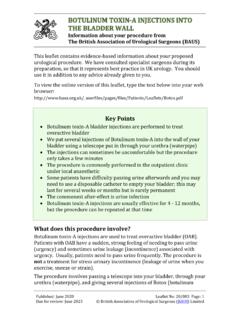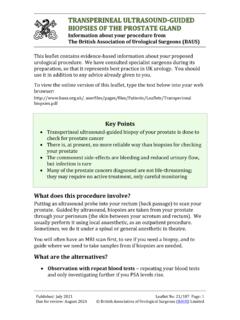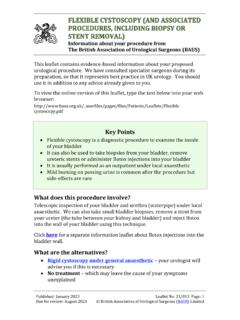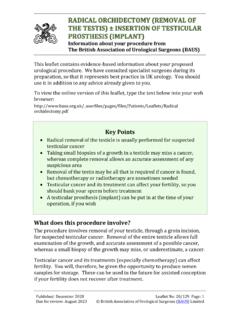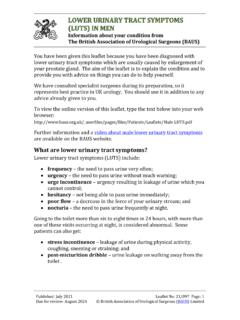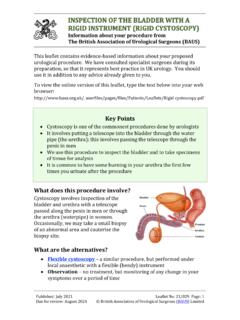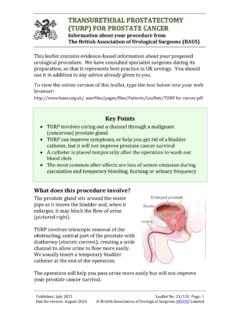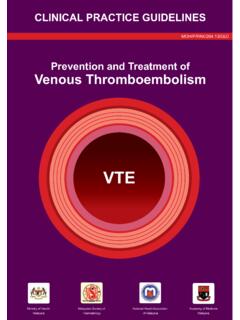Transcription of Key Points - BAUS
1 Information about your procedure from The British Association of Urological Surgeons (BAUS) Published: December 2020 Leaflet No: 20/046 Page: 1 Due for review: August 2023 British Association of Urological Surgeons (BAUS) Limited This leaflet contains evidence-based information about your proposed urological procedure. We have consulted specialist surgeons during its preparation, so that it represents best practice in UK urology. You should use it in addition to any advice already given to you. To view the online version of this leaflet, type the text below into your web browser: What does this procedure involve? A varicocele is a collection of enlarged veins that drain blood from the testicle (pictured), like varicose veins in the leg. Embolisation is a way of blocking these veins, making them less obvious and causing the varicocele to shrivel away without surgery.
2 Key Points Radiological embolisation is a minimally invasive way of treating a varicocele (abnormal. swollen varicose veins above your testicle) Eight out of 10 patients (80%) have a successful outcome from this procedure Varicocele embolisation is less invasive than surgery and is done under local anaesthetic There is no significant risk of testicular atrophy (shrinkage) or development of a hydrocele (fluid around your testicle) compared with surgical approaches Published: December 2020 Leaflet No: 20/046 Page: 2 Due for review: August 2023 British Association of Urological Surgeons (BAUS) Limited What are the alternatives? Observation no treatment if your varicocele is small and causes no symptoms Open surgery either using standard or microsurgical clipping of the veins through a small incision in your groin Laparoscopic repair clipping the varicose veins using a telescope put into your abdominal (tummy) cavity Surgical repair of a varicocele (open or laparoscopic) needs a general anaesthetic, is performed in an operating theatre and requires a period of recovery afterwards.
3 What happens on the day of the procedure? Your radiologist (or a member of radiology staff) will briefly review your history and medications, and will discuss the procedure with you to confirm your consent. Details of the procedure The procedure is done by a specially-trained X-ray doctor called an interventional radiologist. He/she will have special expertise with X-ray or ultrasound equipment, and will use imaging techniques to help during the embolisation procedure. varicocele embolisation is normally performed in a surgical area of the X-ray Department under sterile conditions you may be given an injection of antibiotics before the procedure, after you have been checked carefully for any allergies the interventional radiologist will inject local anaesthetic into your neck or groin once the skin is numb, he/she will put a needle into a large vein under the skin a guidewire is passed through the needle, followed by a narrow tube (catheter), which is steered under X ray control into the enlarged vein that drains blood from the testicle when this tube is in the correct position, the radiologist will inject coils (pictured) or a special liquid to stop the flow of blood from the Published: December 2020 Leaflet No: 20/046 Page.
4 3 Due for review: August 2023 British Association of Urological Surgeons (BAUS) Limited testicle they will take further X rays to confirm that the abnormal veins have been blocked completely the X-ray catheter will be removed and the interventional radiologist will press firmly on the skin puncture point for several minutes to prevent any bleeding You will usually go to a Radiology Day Area for monitoring over the next three to four hours. A nurse will regularly check your blood pressure and pulse, and keep a careful eye on the puncture site to be sure there is no bleeding . We normally ask you to stay in bed for an hour after the procedure. Most patients go home later the same day but, very occasionally, you may need to stay overnight. Are there any after-effects? The possible after-effects and your risk of getting them are shown below.
5 Some are self-limiting or reversible, but others are not. We have not listed very rare after-effects (occurring in less than 1 in 250 patients) individually. The impact of these after-effects can vary a lot from patient to patient; you should ask your surgeon s advice about the risks and their impact on you as an individual: After-effect Risk Bruising at the skin puncture site Between 1 in 2 & 1 in 10 patients Pain around the puncture site which can sometimes worsen in the days after the procedure Between 1 in 2 & 1 in 10 patients Back pain for 48 to 72 hours after the procedure Between 1 in 2 & 1 in 10 patients Infection at the skin puncture site requiring antibiotics or surgical drainage Between 1 in 10 & 1 in 50 patients Published: December 2020 Leaflet No: 20/046 Page: 4 Due for review: August 2023 British Association of Urological Surgeons (BAUS) Limited What is my risk of a hospital-acquired infection?
6 Your risk of getting an infection in hospital is between 4 this includes getting MRSA or a Clostridium difficile bowel infection. This figure is higher if you are in a high-risk group of patients such as patients who have had: long-term drainage tubes ( catheters); bladder removal; long hospital stays; or multiple hospital admissions. What can I expect when I get home? you should rest at home for the remainder of the day you can resume normal activities after 24 hours simple painkillers such as paracetamol should help any discomfort you get the veins above your testicle often become more prominent and tender in the first few days after the procedure; gradually, this becomes less obvious although the veins may not disappear completely any antibiotics or other tablets you may need will be arranged & dispensed from the hospital pharmacy a follow-up appointment will be made for you if you develop a temperature, increased redness or discharge of pus from the site of the puncture, contact your GP or the surgical team looking after you bleeding from the puncture site when you get home is very rare but, if it does happen, press firmly on the site for 10 to 20 minutes.
7 This should stop the bleeding if the bleeding does not stop, you should contact your GP or go to your local Accident & Emergency Department Recurrence of the varicocele Between 1 in 10 & 1 in 50 patients Damage to, or bleeding from, the punctured vein requiring surgical repair Between 1 in 50 & 1 in 250 patients Published: December 2020 Leaflet No: 20/046 Page: 5 Due for review: August 2023 British Association of Urological Surgeons (BAUS) Limited General information about surgical procedures Before your procedure Please tell a member of the medical team if you have: an implanted foreign body (stent, joint replacement, pacemaker, heart valve, blood vessel graft); a regular prescription for a blood thinning agent ( warfarin, aspirin, clopidogrel, rivaroxaban, dabigatran); a present or previous MRSA infection; or a high risk of variant-CJD ( if you have had a corneal transplant, a neurosurgical dural transplant or human growth hormone treatment).
8 Before you go home The radiologist will tell you how the procedure went and you should: make sure you understand what has been done; ask if everything went as planned; let the staff know if you have any discomfort; ask what you can (and cannot) do at home; make sure you know what happens next; and ask when you can return to normal activities. We will give you advice about what to look out for when you get home. Your radiologist or nurse will also give you details of who to contact, and how to contact them, in the event of problems. Smoking and surgery Ideally, we would prefer you to stop smoking before any procedure. Smoking can worsen some urological conditions and makes complications more likely after surgery. For advice on stopping, you can: contact your GP; access your local NHS Smoking Help Online; or ring the free NHS Smoking Helpline on 0300 123 1044.
9 Driving after surgery It is your responsibility to make sure you are fit to drive after any procedure. You only need to contact the DVLA if your ability to drive is likely to be affected for more than three months. If it is, you should check with your insurance company before driving again. Published: December 2020 Leaflet No: 20/046 Page: 6 Due for review: August 2023 British Association of Urological Surgeons (BAUS) Limited What should I do with this information? Thank you for taking the trouble to read this information. Please let your urologist (or specialist nurse) know if you would like to have a copy for your own records. If you wish, they can also arrange for a copy to be kept in your hospital notes. What sources were used to prepare this leaflet? This leaflet uses information from consensus panels and other evidence-based sources including: the Department of Health (England) the Cochrane Collaboration the National Institute for Health and Care Excellence (NICE) the Royal College of Radiologists the British Institute of Radiology It also follows style guidelines from: the Royal National Institute for Blind People (RNIB); the Patient Information Forum; and the Plain English Campaign.
10 Disclaimer We have made every effort to give accurate information but there may still be errors or omissions in this leaflet. BAUS cannot accept responsibility for any loss from action taken (or not taken) as a result of this information. PLEASE NOTE The staff at BAUS are not medically trained, and are unable to answer questions about the information provided in this leaflet. If you do have any questions, you should contact your urologist, specialist nurse or GP.

